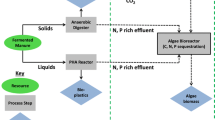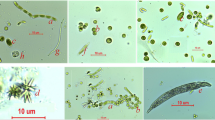Abstract
An alternative to land spreading of manure effluents is to mass-culture algae on the N and P present in the manure and convert manure N and P into algal biomass. The objective of this study was to determine how the fatty acid (FA) content and composition of algae respond to changes in the type of manure, manure loading rate, and to whether the algae was grown with supplemental carbon dioxide. Algal biomass was harvested weekly from indoor laboratory-scale algal turf scrubber (ATS) units using different loading rates of raw and anaerobically digested dairy manure effluents and raw swine manure effluent. Manure loading rates corresponded to N loading rates of 0.2 to 1.3 g TN m−2 day−1 for raw swine manure effluent and 0.3 to 2.3 g TN m−2 day−1 for dairy manure effluents. In addition, algal biomass was harvested from outdoor pilot-scale ATS units using different loading rates of raw and anaerobically digested dairy manure effluents. Both indoor and outdoor units were dominated by Rhizoclonium sp. FA content values of the algal biomass ranged from 0.6 to 1.5% of dry weight and showed no consistent relationship to loading rate, type of manure, or to whether supplemental carbon dioxide was added to the systems. FA composition was remarkably consistent among samples and >90% of the FA content consisted of 14:0, 16:0, 16:1ω7, 16:1ω9, 18:0, 18:1ω9, 18:2 ω6, and 18:3ω3.
Similar content being viewed by others
References
Adey WH, Loveland K (2007) Dynamic aquaria: building living ecosystems, 3rd edn. Academic Press, New York
Aresta M, Dibenedetto A, Barberio G (2005) Utilization of macro-algae for enhanced CO2 fixation and biofuels production: Development of a computing software for an LCA study. Fuel Process Technol 86:1679–1693
Benemann JR, Oswald WJ (1996) Systems and economic analysis of microalgae ponds for conversion of carbon dioxide to biomass. Pittsburgh Energy Technology Center Pittsburgh, PA Available via http://govdocs.aquake.org/cgi/reprint/2004/915/9150050 Cited 1 August 2007
Chen PH, Oswald WJ (1998) Thermochemical treatment for algal fermentation. Environ Int 24(8):889–897
Chesapeake Bay Foundation (2004) Manure’s impact on rivers, streams and the Chesapeake Bay. Chesapeake Bay Foundation, Annapolis, MD Available via http://www.cbf.org/site/DocServer/0723manurereport_noembargo_.pdf?docID=2143 Cited 1 Aug 2007
Chisti Y (2007) Biodiesel from microalgae. Biotechnol Adv 25:294–306
Craggs RJ, Adey WH, Jenson KR, St. John MS, Green FB, Oswald WJ (1996) Phosphorus removal from wastewater using an algal turf scrubber. Water Sci Technol 33:191–198
Craggs RJ, Tanner CC, Sukias JP, Davies-Colley RJ (2003) Dairy farm wastewater treatment by an advanced pond system. Water Sci Technol 48:291–297
Dionex (2004) Methods optimization in accelerated solvent extraction (ASE). Technical note 208 Available via http://www1.dionex.com/en-us/webdocs/4736_TN208.pdf Cited 1 Aug 2007
Goh A (1986) Production of microalgae using pig waste as a substrate. In: Barclay WR, McIntosh RP (eds) Algal biomass technologies. Cramer, Berlin, pp 235–244
Hoffman J (1998) Wastewater treatment with suspended and nonsuspended algae. J Phycol 34:757–763
Kebede-Westhead E, Pizarro C, Mulbry WW (2003) Production and nutrient removal by periphyton grown under different loading rates of anaerobically digested flushed dairy manure. J Phycol 39:1275–1282
Kebede-Westhead E, Pizarro C, Mulbry W (2006) Treatment of swine manure effluent using freshwater algae: production, nutrient recovery, and elemental composition of algal biomass at four effluent loading rates. J Appl Phycol 18:41–46
Li X, Xu H, Wu Q (2007) Large-scale biodiesel production from microalga Chlorella protothecoides through heterotrophic cultivation in bioreactors. Biotechnol Bioeng 98:764–771
Lincoln EP, Wilkie AC, French BT (1996) Cyanobacterial process for renovating dairy wastewater. Biomass Bioenergy 10:63–68
Luthria D, Vinjamoori D, Noel K, Ezzell J (2004) Accelerated solvent extraction. In: Luthria D (ed) Oil extraction and analysis: critical issues and comparative studies. AOCS, Champaign, IL, pp 25–38
Minowa T, Sawayama S (1999) A novel microalgal system for energy production with nitrogen cycling. Fuel 78:1213–1215
Molina Grima E, Belarbi E-H, Acien Fernandez FG, Robles Medina A, Chisti Y (2003) Recovery of microalgal biomass and metabolites: process options and economics. Biotechnol Adv 20:491–515
Mulbry W, Kebede-Westhead E, Pizarro C, Sikora LJ (2005) Recycling of manure nutrients: use of algal biomass from dairy manure treatment as a slow release fertilizer. Bioresour Technol 96:451–458
Olguin EJ (2003) Phycoremediation: key issues for cost-effective nutrient removal processes. Biotechnol Adv 22:81–91
Piorreck M, Pohl P (1984) Formation of biomass, total protein, chlorophylls, lipids and fatty acids in freshwater green and blue-green algae under different nitrogen regimes. Phytochemistry 23:207–216
Pizarro C, Mulbry W, Blersch M, Kangas P (2006) An economic assessment of algal turf scrubber technology for treatment of dairy manure effluent. Ecol Eng 26:321–327
SAS Institute Inc (2004) SAS/STAT® 9.1 User’s Guide. SAS Institute Inc, Cary, NC, p 5124
Sawayama S, Minowa T, Yokoyama S-Y (1999) Possibility of renewable energy production and CO2 mitigation by thermochemical liquefaction of microalgae. Biomass Bioenergy 17:33–39
Schafer K (1998) Accelerated solvent extraction of lipids for determining the fatty acid composition of biological material. Anal Chim Acta 358:69–77
Sheehan J, Dunahay T, Benemann JR, Roessler P, Weissman JC. (1998) A look back at the U.S. Department of Energy’s aquatic species program–biodiesel from algae NREL/TP-580–24190. National Renewable Energy Laboratory, Golden Available via http://www1.eere.energy.gov/biomass/pdfs/biodiesel_from_algae.pdf Cited 1 Aug 2007
Shifrin NS, Chisholm SW (1981) Phytoplankton lipids: interspecific differences and effects of nitrate, silicate and light-dark cycles. J Phycol 17:374–384
Wilkie AC, Mulbry WW (2002) Recovery of dairy manure nutrients by benthic freshwater algae. Bioresour Technol 84:81–91
Wood BJB (1988) Lipids of algae and protozoa. In: Ratledge C, Wilkinson SG (eds) Microbial Lipids. Academic, London, pp 807–867
Acknowledgments
We gratefully acknowledge Folasade Ogundipe for her help with algal extractions, Dr. Mary Camp for statistical analyses, and Dr. Dave Luthria for providing guidance on lipid extraction techniques.
Author information
Authors and Affiliations
Corresponding author
Rights and permissions
About this article
Cite this article
Mulbry, W., Kondrad, S. & Buyer, J. Treatment of dairy and swine manure effluents using freshwater algae: fatty acid content and composition of algal biomass at different manure loading rates. J Appl Phycol 20, 1079–1085 (2008). https://doi.org/10.1007/s10811-008-9314-8
Received:
Revised:
Accepted:
Published:
Issue Date:
DOI: https://doi.org/10.1007/s10811-008-9314-8




